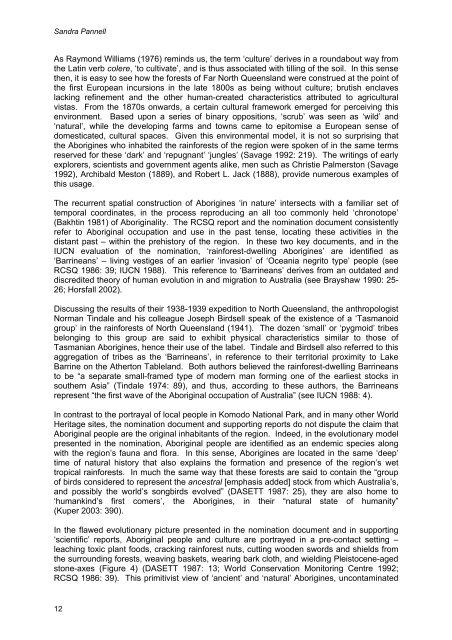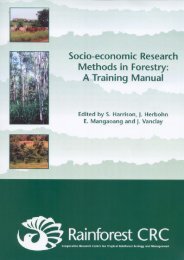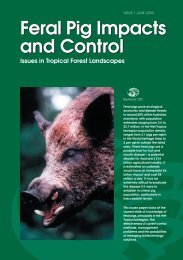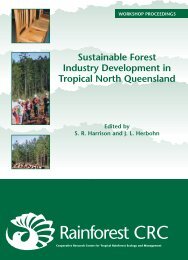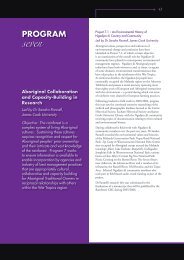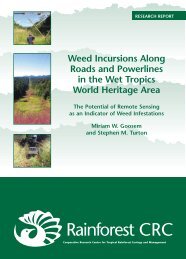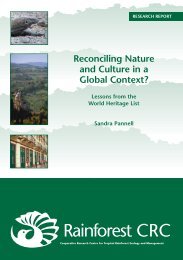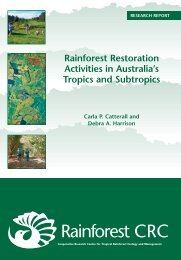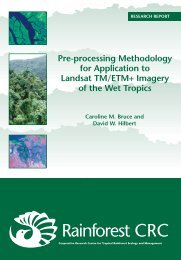Reconciling Nature and Culture in a Global Context? - Rainforest ...
Reconciling Nature and Culture in a Global Context? - Rainforest ...
Reconciling Nature and Culture in a Global Context? - Rainforest ...
Create successful ePaper yourself
Turn your PDF publications into a flip-book with our unique Google optimized e-Paper software.
S<strong>and</strong>ra PannellAs Raymond Williams (1976) rem<strong>in</strong>ds us, the term ‘culture’ derives <strong>in</strong> a roundabout way fromthe Lat<strong>in</strong> verb colere, ‘to cultivate’, <strong>and</strong> is thus associated with till<strong>in</strong>g of the soil. In this sensethen, it is easy to see how the forests of Far North Queensl<strong>and</strong> were construed at the po<strong>in</strong>t ofthe first European <strong>in</strong>cursions <strong>in</strong> the late 1800s as be<strong>in</strong>g without culture; brutish enclaveslack<strong>in</strong>g ref<strong>in</strong>ement <strong>and</strong> the other human-created characteristics attributed to agriculturalvistas. From the 1870s onwards, a certa<strong>in</strong> cultural framework emerged for perceiv<strong>in</strong>g thisenvironment. Based upon a series of b<strong>in</strong>ary oppositions, ‘scrub’ was seen as ‘wild’ <strong>and</strong>‘natural’, while the develop<strong>in</strong>g farms <strong>and</strong> towns came to epitomise a European sense ofdomesticated, cultural spaces. Given this environmental model, it is not so surpris<strong>in</strong>g thatthe Aborig<strong>in</strong>es who <strong>in</strong>habited the ra<strong>in</strong>forests of the region were spoken of <strong>in</strong> the same termsreserved for these ‘dark’ <strong>and</strong> ‘repugnant’ ‘jungles’ (Savage 1992: 219). The writ<strong>in</strong>gs of earlyexplorers, scientists <strong>and</strong> government agents alike, men such as Christie Palmerston (Savage1992), Archibald Meston (1889), <strong>and</strong> Robert L. Jack (1888), provide numerous examples ofthis usage.The recurrent spatial construction of Aborig<strong>in</strong>es ‘<strong>in</strong> nature’ <strong>in</strong>tersects with a familiar set oftemporal coord<strong>in</strong>ates, <strong>in</strong> the process reproduc<strong>in</strong>g an all too commonly held ‘chronotope’(Bakht<strong>in</strong> 1981) of Aborig<strong>in</strong>ality. The RCSQ report <strong>and</strong> the nom<strong>in</strong>ation document consistentlyrefer to Aborig<strong>in</strong>al occupation <strong>and</strong> use <strong>in</strong> the past tense, locat<strong>in</strong>g these activities <strong>in</strong> thedistant past – with<strong>in</strong> the prehistory of the region. In these two key documents, <strong>and</strong> <strong>in</strong> theIUCN evaluation of the nom<strong>in</strong>ation, ‘ra<strong>in</strong>forest-dwell<strong>in</strong>g Aborig<strong>in</strong>es’ are identified as‘Barr<strong>in</strong>eans’ – liv<strong>in</strong>g vestiges of an earlier ‘<strong>in</strong>vasion’ of ‘Oceania negrito type’ people (seeRCSQ 1986: 39; IUCN 1988). This reference to ‘Barr<strong>in</strong>eans’ derives from an outdated <strong>and</strong>discredited theory of human evolution <strong>in</strong> <strong>and</strong> migration to Australia (see Brayshaw 1990: 25-26; Horsfall 2002).Discuss<strong>in</strong>g the results of their 1938-1939 expedition to North Queensl<strong>and</strong>, the anthropologistNorman T<strong>in</strong>dale <strong>and</strong> his colleague Joseph Birdsell speak of the existence of a ‘Tasmanoidgroup’ <strong>in</strong> the ra<strong>in</strong>forests of North Queensl<strong>and</strong> (1941). The dozen ‘small’ or ‘pygmoid’ tribesbelong<strong>in</strong>g to this group are said to exhibit physical characteristics similar to those ofTasmanian Aborig<strong>in</strong>es, hence their use of the label. T<strong>in</strong>dale <strong>and</strong> Birdsell also referred to thisaggregation of tribes as the ‘Barr<strong>in</strong>eans’, <strong>in</strong> reference to their territorial proximity to LakeBarr<strong>in</strong>e on the Atherton Tablel<strong>and</strong>. Both authors believed the ra<strong>in</strong>forest-dwell<strong>in</strong>g Barr<strong>in</strong>eansto be “a separate small-framed type of modern man form<strong>in</strong>g one of the earliest stocks <strong>in</strong>southern Asia” (T<strong>in</strong>dale 1974: 89), <strong>and</strong> thus, accord<strong>in</strong>g to these authors, the Barr<strong>in</strong>eansrepresent “the first wave of the Aborig<strong>in</strong>al occupation of Australia” (see IUCN 1988: 4).In contrast to the portrayal of local people <strong>in</strong> Komodo National Park, <strong>and</strong> <strong>in</strong> many other WorldHeritage sites, the nom<strong>in</strong>ation document <strong>and</strong> support<strong>in</strong>g reports do not dispute the claim thatAborig<strong>in</strong>al people are the orig<strong>in</strong>al <strong>in</strong>habitants of the region. Indeed, <strong>in</strong> the evolutionary modelpresented <strong>in</strong> the nom<strong>in</strong>ation, Aborig<strong>in</strong>al people are identified as an endemic species alongwith the region’s fauna <strong>and</strong> flora. In this sense, Aborig<strong>in</strong>es are located <strong>in</strong> the same ‘deep’time of natural history that also expla<strong>in</strong>s the formation <strong>and</strong> presence of the region’s wettropical ra<strong>in</strong>forests. In much the same way that these forests are said to conta<strong>in</strong> the “groupof birds considered to represent the ancestral [emphasis added] stock from which Australia’s,<strong>and</strong> possibly the world’s songbirds evolved” (DASETT 1987: 25), they are also home to‘humank<strong>in</strong>d’s first comers’, the Aborig<strong>in</strong>es, <strong>in</strong> their “natural state of humanity”(Kuper 2003: 390).In the flawed evolutionary picture presented <strong>in</strong> the nom<strong>in</strong>ation document <strong>and</strong> <strong>in</strong> support<strong>in</strong>g‘scientific’ reports, Aborig<strong>in</strong>al people <strong>and</strong> culture are portrayed <strong>in</strong> a pre-contact sett<strong>in</strong>g –leach<strong>in</strong>g toxic plant foods, crack<strong>in</strong>g ra<strong>in</strong>forest nuts, cutt<strong>in</strong>g wooden swords <strong>and</strong> shields fromthe surround<strong>in</strong>g forests, weav<strong>in</strong>g baskets, wear<strong>in</strong>g bark cloth, <strong>and</strong> wield<strong>in</strong>g Pleistocene-agedstone-axes (Figure 4) (DASETT 1987: 13; World Conservation Monitor<strong>in</strong>g Centre 1992;RCSQ 1986: 39). This primitivist view of ‘ancient’ <strong>and</strong> ‘natural’ Aborig<strong>in</strong>es, uncontam<strong>in</strong>ated12


